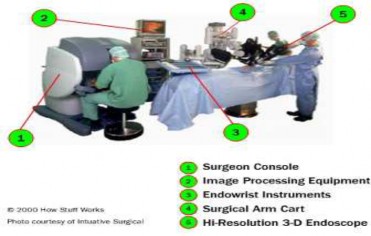32. ROBOTIC SURGERY-
♤ Robotic surgery is a technique in which a surgeon performs surgery using a computer that remotely controls very small instruments attached to a robot.
♤ The surgeon first inserts these instruments into your body through small surgical cuts. Under the surgeon's direction, the robot matches the doctor's hand movements to perform the procedure using the tiny instruments.
♤ A thin tube with a camera attached to the end of it (endoscope) allows the surgeon to view highly magnified three-dimensional images of your body on a monitor in real time.


♤ Major advances aided by surgical robots have been remote surgery, minimally invasive surgery and unmanned surgery. Some major advantages of robotic surgery are precision, miniaturization, smaller incisions, decreased blood loss, less pain, and quicker healing time. Further advantages are articulation beyond normal manipulation and three-dimensional magnification, resulting in improved ergonomics. Robotic techniques are also associated with reduced duration of hospital stays, blood loss, transfusions, and use of pain medication.


